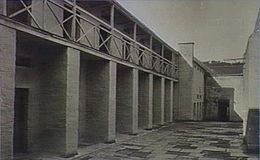Cascades Female Factory
| Australian Convict Sites | |
|---|---|
|
UNESCO world heritage |
|

|
|
| Cascades Female Factory building section |
|
| National territory: | Australia |
| Type: | World Heritage |
| Criteria : | (iv) (vi) |
| Reference No .: | 1306 |
| UNESCO region : | Asia and Pacific |
| History of enrollment | |
| Enrollment: | 2010 (session 34) |
The Cascades Female Factory was a prison for female convicts from England and operated in Hobart , Tasmania from 1828 to 1856 . Australia was one of the few places in the world where female convicts were posted. During the colonial period, a total of 134,000 convicts were deported from Great Britain to Australia, including 25,000 women. Over half of the female deportees came to Tasmania, what was then Van Diemen's Land.
Most of the female convicts and their children spent at least some time in the Cascades Female Factory, which is considered a place of inhuman treatment and great suffering.
Due to its historical and cultural importance, the building has been listed as one of eleven Australian Convict Sites since 2010 on the Australian National Heritage List and on the UNESCO World Heritage List.
Women as convicts
In 19th century Britain, the smallest offenses, such as stealing bread for starvation, were punishable by the death penalty . Later the sentences were often reduced and the convicts were deported to Australia for convict labor .
At the beginning of the colonization , female convicts were still regarded as important members of society, as later wives, mothers and as service personnel. In the beginning women were not placed in separate prisons. However, as the number of female convicts increased, this attitude changed and they were now considered undesirable and immoral. This paradigm shift led to women's prisons being built to discipline and integrate female convicts into society. These prisons were used to educate people in work and religion and to adapt. They were also placed in prison if the women were sick, unable to work, or rebellious.
The idea that work and education could restore female convicts to a respected part of society was widespread. They also hoped for a solution to society's growth problem, because due to the shortage of women, the ratio of men to women in Tasmania was then 10: 1. The first reform efforts emerged, with the reformer Elizabeth Fry first calling for the establishment of women's prisons with women's staff in 1823.
From 1838 the treatment of female convicts changed: the newly arrived women were instructed in the basics of reading and writing for six months after their arrival and kept away from other convicts. After these six months they could be handed over to settlers as domestic helpers.
Accommodation and living conditions
The administrative center of the Cascades Female Factory was in courtyard 1, which in 1828 housed 100 women. Hof 1 was originally a distillery; the walled area was divided into a hospital, a nursing home, a kitchen, a shop, workshops and a chapel.
Courtyard 3, which was built in 1845 and contained 112 single cells, was used to punish the female convicts by isolating them. Courtyards 1, 2 and 3 also contained single cells. Punishments included cutting hair, wearing iron chains, and hard labor. Women and their children had to wear prison clothes.
In courtyard 4, which was specially built as a nursing home for convict mothers from 1850, they and their children were separated from three to nine months of age. After this time the mothers were housed in other buildings in the factory . The infant death rate was high from premature births and the unsanitary conditions in the prison. Children who survived were sent to schools in Hobart when they were two to three years old and raised there by other women.
The Cascade Female Factory quickly became known for its high disease and death rates, well above Hobart's, which led to investigation. In 1838 208 of 794 children born there had died.
building
The prison buildings were in marshland, which caused serious health problems for the women and their children because of the damp and cold.
When the prisoner transports to Tasmania ended in 1853, the Cascades Female Factory was used as a prison, later as a poor house, as a hospital, and for other charitable purposes. In 1905 the site and buildings were sold and the owner dismantled the buildings. The enclosure wall that enclosed courtyards 1, 3 and 4 and the staff building in courtyard 4 was retained.
Web links
Individual evidence
- ↑ Arthur Phillip : Australia. The establishment of the penal colony p. 24. 1st edition, Lamuv, Göttingen 2001
- ↑ a b c d e f Cascades Female Factory mor information at www.environment.gov.au . Retrieved January 23, 2011
Coordinates: 42 ° 53 ′ 38 ″ S , 147 ° 17 ′ 57 ″ E
